The 12 Full Moons Of 2024 And What They Mean
As we usher in a new year, it's important to look ahead so we can best prepare, schedule, and plan how and when we want to use certain energies. The full moon schedule is especially important for that, so we can all align ourselves with the lunar cycles.
Below, you'll find every full moon happening this year, when they're taking place, and the meaning behind their names, so you may become more informed and prepared than ever, a practical first step in your year's journey.
Being aware of the moon's cycles is important, but there's so much more than that out there, so many celestial motions taking place that have great influence over our lives. You can tap into this wealth of knowledge from the universe, but you'll need some guidance first.
A full astrological chart reading will inform you of all the ways the stars and planets impact your life. Learn what that means for your past, present, and future by clicking here today.
January 25th - Wolf Moon

The first full moon of 2024 will be the Wolf Moon on January 25th, named as such for the wolves that can be heard howling during the peak of winter.
The name could also be derived from Anglo-Saxon culture, where January was called Wulf Monath or Wolf Month. Calling to the harsh winter season, this moon is also known as the Severe Moon or Hard Moon in Gaelic.
In modern times, this moon is sometimes called the Old Moon, the Moon After Yule, or the Full Snow Moon.
February 24th - Snow Moon

Though most people save Snow Moon for February's full moon, which will take place on the 24th of February this year.
This moon is rather aptly named for the heavy snow we tend to see in February across much of North America, though the difficult winter inspired a few other names over the centuries. Due to activities like hunting becoming nigh-impossible during winter, this moon was also sometimes called the Hunger Moon or the Storm Moon.
March 25th - Worm Moon

One of the seemingly stranger names on the list, on March 25th, we'll see the full Worm Moon rise in our night skies.
It refers to the start of spring, the way the ground begins to thaw, and worms that were resting dormant in the dirt begin to rise to the surface again. This moon also goes by the Crow Moon, as this is when we'll start to hear the call of birds returning from their winters south, or the Sap Moon, as this is when maple trees should be tapped for their sap.
April 23rd - Pink Moon

Sadly, the Pink Moon does not actually mean the moon will appear pink when it rises on April 23rd of this year. Instead, the choice of the color pink is meant to signify the full arrival of spring, as that's when creeping phlox, a pink wildflower seen across The United States, starts blooming once again.
This moon has plenty of other known names, most having to do with the return of plants and animals. Moon of the Red Grass, Frog Moon, Moon of Blackberry, New Shoots Moon, Moon When The Ducks Come Back, and Growing Moon are just some examples!
May 23rd - Flower Moon

The Flower Moon, happening on May 23rd this year, has a name very closely related to April's. It signifies spring being in full swing, flowers blooming again just ahead of the summer, bringing color and life back into our lives.
This is another month that has plenty of alternative names based on plant and animal behavior. There's Egg Laying Moon, Moon of the Shedding Ponies, Corn Planting Moon, and Hare Moon, just to name a few.
June 21st - Strawberry Moon

This is another name that sometimes leads people to believe that the moon will appear pink in the sky, but that's unfortunately not true. Instead, this moon, rising on June 21st, is named due to June being strawberry harvesting season in much of North America.
This is similar to another known name for it, Berries Ripen Moon, though it also goes by Blooming Moon, Green Corn Moon, and, in Europe, the Rose Moon.
July 21st - Buck Moon

The Buck Moon, taking place on July 21st, is named after the antlers of the majestic buck. See, deer spend the rest of the year shedding and regrowing their antlers, but in July, these antlers are at their biggest, fullest, and most royal-looking.
Some other names, derived from weather patterns, plants, and other animal behavior, include Feather Molting Moon, Berry Moon, Month Of The Ripe Corn Moon, Thunder Moon, and Salmon Moon, which is funny as August's full moon is also named after a specific fish.
August 19th - Sturgeon Moon

On August 19th, we'll be seeing the Sturgeon Moon rise, another rather unique name in the year's lineup. This name comes from the Indigenous and Native American populations living in the Great Lakes region, as large flocks of sturgeon would fill the waters during this time.
It's also known as the Flying Up Moon, as this is when baby birds would begin learning how to fly, the Black Cherries Moon, the Grain Moon, and the Red Moon, named after the slight red tint it can sometimes adopt in the summer light.
September 17th - Harvest Moon

The Harvest Moon, rising on September 17th, is named that for exactly the reason you think. Now's the time when a lot of hearty, staple crops, namely corn, are ready to harvest. The name of this moon can actually change depending on which full moon is closest to the autumnal equinox. If September's is closest, it's the Harvest Moon, but if October's is closest, then October's becomes the Harvest Moon and September's is called the Corn Moon instead.
Other known names include the Falling Leaves Moon, Barley Moon, and Child Moon.
October 17th - Hunter's Moon

As mentioned, October's moon can also change names, but this year, it remains the Hunter's Moon, and it rises on October 17th.
This moon is named as October marks the start of hunting season, or it did in more ancient cultures. The moon is bright at this time, making it easier for hunters to see above vegetation (which is beginning to die out before winter) and spot animals to be hunted ahead of any migration or hibernation. This moon can also be called the Travel Moon and the Dying Grass Moon.
November 15th - Beaver Moon

The Beaver Moon, visible on November 15th, is named after the seasonal preparation done by, you guessed it, the beaver. It's in November that beavers will start building lodges and filling them with food to sustain them throughout the winter.
As this is when temperatures tend to start really dropping, this moon is also known as the Freezing Moon, the Heading To Winter Moon, and the Frost Moon, all noted for the cold temperatures heading into winter.
December 15th - Cold Moon

Speaking of cold temperatures, December's full moon is the Cold Moon, which will rise on December 15th. This name is rather self-explanatory, as it marks the especially cold season of winter as it really settles in throughout the month.
It's also known as the Long Night Moon, the Oak Moon, and the Snow Moon (though, as mentioned, that's more often attributed to February). Just like January's full moon is sometimes called the Moon After Yule, December's can be known as the Moon Before Yule.





